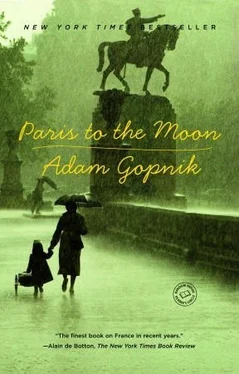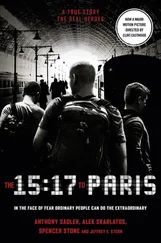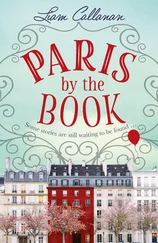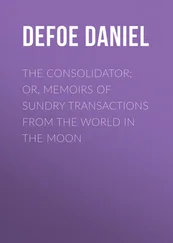I think that I only really began to grasp just how serious the strike was when the chickens stopped rotating at the outdoor market in my neighborhood. Several poultry merchants there keep chickens and coquelets and rabbits and pheasants spitted and broiling on outdoor rotisseries all through the year, even in August and in the quiet days after Christmas. One afternoon a few days into the strike I walked over to the market to check on the progress of a turkey I had ordered from one of the rotisseurs, to be sent up from the country for a belated Thanksgiving, and I noticed that he had unspitted all his birds and turned off the grill. This seemed to me one of those signs that reporters abroad are supposed to treat as portents (“It has long been said in the bazaars that when the chickens stop turning, the government will fall”), and as I approached to ask what he was doing, he gestured grimly in the direction of the boulevard Saint-Germain.
“Ca commence,” he said grimly. It’s beginning, though what, exactly, was beginning I wasn’t sure.
“The turkey, it’s still on its way?” I asked, with the stupid inconsequence common to people caught up in revolutions. (“ Rien ,” Louis XVI noted in his diary the day the Bastille was stormed.)
He shook his head gravely, implying, I thought for a moment, that the strike might have spread to the fowl too. Then he gestured again toward the boulevard.
For about ten solid blocks, on each side of the boulevard aint-Germain a row of tourist buses was parked; that, considering the severity with which the cops normally enforce the no-parking regulations, was in itself a near-insurrectionary sight.
The buses bore on their windshields notices indicating where their journeys had begun—Lyons, Grenoble, Bordeaux—and, in their side windows, little stickers saying “FO,” for Force Ouvriere, or Workers’ Force. (Despite the militant name, it is the more moderate of the big French labor federations.) Inside, the bus drivers looked bored and sleepy after the long trip in from the provinces. But between the two rows of buses thousands of FO members, from all across France, were marching up the boulevard, three or four abreast. Then came a rear guard of students armed with batons and occasional bricks. The noise, oddly, was confined, cozily insulated by the parked coaches, a revolution taking place in a bus depot. Farther east on the boulevard, beyond the buses, the French riot police were lined up and waiting, in helmets and shields. There wasn’t any violence then, and there hasn’t been too much since, but around that time it began to seem that the French were trying on, if only for a moment, long-discarded revolutionary roles, albeit in a slightly unreal setting: strikers taking buses to the revolution, students relearning the lore of the heaved cobblestone.
The strike had begun, on Friday, November 24, as a one-day job action, led by the railroad workers. The Juppe government was still in a state of self-congratulatory, mildly Gingrichian delight over the austerity measures that it had announced to reform the expensive social security system of the French state. The cheminots, as the railroad workers are called, hated this idea, because a lot of money is put directly into their pension fund by the government, an outright subsidy, which makes the railroad workers less employees of a profit-seeking enterprise than subsidized functionaries of a state cultural treasure, like members of the Comedie Francaise. (Although the train system loses money, it is one of the glories of France.) Perhaps the government doubted whether the cheminots could command much sympathy since their specific grievance seemed absurdly small (many of them would no longer be able to retire at fifty at full pay) and since the unions have receded as drastically in France in the past fifteen years as they have in America, maybe more so. One in every ten French workers still belongs to a union, but most of the unionized workers are ensconced for life in the public sector or in subsidized state-run enterprises. What the unions have lost in numbers though, they have gained in freedom to maneuver and in symbolic force. They are no longer the vanguard of the revolution. Now they are the shock troops of the bourgeoisie.
Meanwhile a strike by university students, which had begun outside Paris, came to town too. The students wanted smaller classes and more money, and the government didn’t foresee any possible sharing of interests between them and the cheminots; what’s more, it didn’t see how a student strike could claim center stage in a country that has suffered consistently from 10 percent unemployment. Yet the government underestimated the extraordinary hold that the word student has on the French imagination, a little like the hold the word farmer has on Americans. In fact the phrase student movement has in France much the same magic that the phrase family farm has in America, conjuring up an idealized past, even for people who never took part in a student movement or lived on a family farm. For a week the students and the cheminots took turns working over the Chirac-Juppe government, like a veteran tag-team wrestling pair going against a couple of beardless innocents. They did such a good job that more groups began to jump into the ring. First, the Metro workers went out, and then the postal workers, and then the employees of France Telecom. No one knows who may go next.
Though the strike has developed a quasi-revolutionary momentum, it doesn’t have anything like a quasi-revolutionary ideology; the slogan of the government functionaries at the heart of the strike is, essentially, “Status quo forever.” The tone is entirely middle class; it suggests a vast petit bourgeois ghost dance, trying to summon up, by its fervor and intensity, a certainty that the future will be like the trentes glorieuses, the glorious thirty years of French prosperity that ended in the late seventies. That is why even French people who don’t belong to unions support the strike; a poll taken a week into the strike showed that just over 60 percent of them were sympathetic to it.
A few days after the demonstration, I went back to the rotisseur to see how the turkey was getting along on its way into town. “It does not look good,” he said. “The strike prevents him from moving.”
“Was he planning to take the TGV?” I asked.
Although workers and students are striking throughout France, the strike is chiefly a Parisian event. That doesn’t make it any less national, since France is a completely centralized country. To achieve in America the effect that the strikers have achieved here, it would be necessary to shut down simultaneously the New York subway, the Washington post office, and the Santa Monica Freeway. These weeks have been unusually cold, and that has made the troubles of the strike more difficult. The strike has even produced an iconography of endurance: lots of pictures of bicyclists and Rollerbladers and sailors, carrying on. But in fact the iconography is a little misleading. More typical sights are the endless bouchons, or traffic jams, which have made a twenty-minute trip from the Etoile to the place de Clichy last four hours. On the great boulevards and avenues there is a constant press of cars and people, marches one day and solid, immovable traffic jams the next. But if you walk only a couple of blocks away in any direction, the city looks especially beautiful, and you can have it to yourself. Despite the strike, all the Christmas decorations are up, shiny red and gold ribbon and green garlands draped like bunting around the display windows of the boutiques. Since almost everyone is busy not getting anywhere in a car, you can be all alone with the gleaming glass storefronts and the Christmas garlands and the sight of your own breath.
Читать дальше












